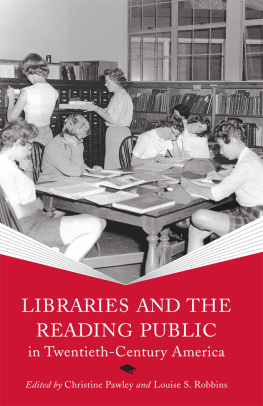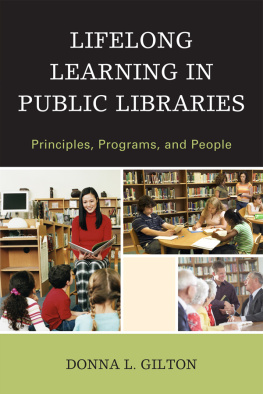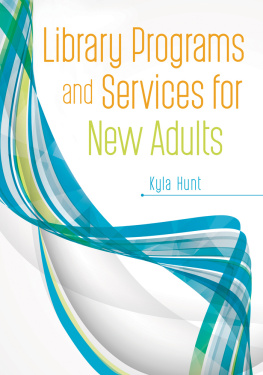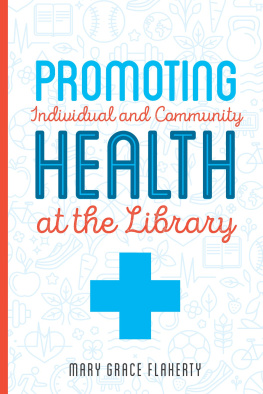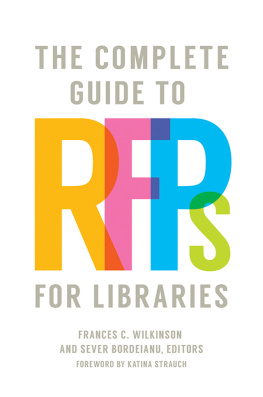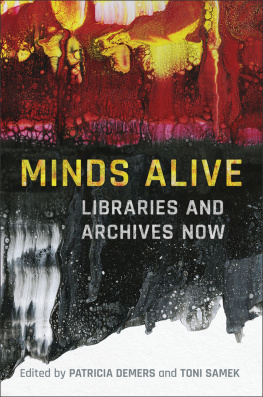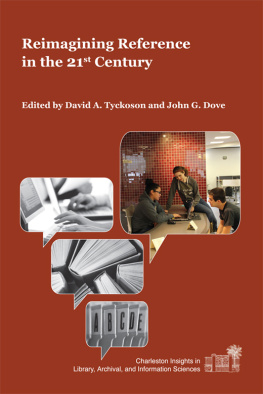Libraries and the Reading Public
in Twentieth-Century America
Print Culture History in Modern America
J AMES P. D ANKY , C HRISTINE P AWLEY , and
A DAM R. N ELSON ,
Series Editors
Libraries and the Reading Public
in Twentieth-Century America

Edited by
C HRISTINE P AWLEY and L OUISE S. R OBBINS
THE UNIVERSITY OF WISCONSIN PRESS
Publication of this volume has been made possible, in part, through support from the Anonymous Fund of the University of WisconsinMadison, the Brittingham Fund, Demco Corporation, the Library History Round Table of the American Library Association, the School of Library and Information Studies, and the University of Wisconsin Libraries.
The University of Wisconsin Press
1930 Monroe Street, 3rd Floor
Madison, Wisconsin 53711-2059
uwpress.wisc.edu
3 Henrietta Street
London WC2E 8LU, England
eurospanbookstore.com
Copyright 2013
The Board of Regents of the University of Wisconsin System All rights reserved. No part of this publication may be reproduced, stored in a retrieval system, or transmitted, in any format or by any means, digital, electronic, mechanical, photocopying, recording, or otherwise, or conveyed via the Internet or a website without written permission of the University of Wisconsin Press, except in the case of brief quotations embedded in critical articles and reviews.
Printed in the United States of America
Library of Congress Cataloging-in-Publication Data
Libraries and the reading public in twentieth-century America / edited by
Christine Pawley and Louise S. Robbins.
p. cm. (Print culture history in modern America)
Includes bibliographical references and index.
ISBN 978-0-299-29324-6 (pbk. : alk. paper) ISBN 978-0-299-29323-9 (e-book)
1. Public librariesUnited StatesHistory20th century. 2. Books and reading
United StatesHistory20th century. I. Pawley, Christine, 1945
II. Robbins, Louise S. III. Series: Print culture history in modern America.
Z731.L546 2013
027.473dc23
2012040073
Contents
WAYNE A. WIEGAND
FRANK FELSENSTEIN, JOHN STRAW, KATHARINE LEIGH, AND JAMES J. CONNOLLY
ROSS HARVEY
JANE AIKIN
ELLEN M. POZZI
JOYCE M. LATHAM
JEAN PREER
JULIA SKINNER
JOAN BESSMAN TAYLOR
LORETTA M. GAFFNEY
EMILY KNOX
ALYCIA SELLIE
JANICE A. RADWAY
Preface
Libraries and the Reading Public is a volume in the series Print Culture History in Modern America, a project of the Center for the History of Print and Digital Culture (CHPDC) at the University of WisconsinMadison. This series focuses particularly on the mediating roles print has played in American culture since 1876. Its scope encompasses studies of newspapers, books, periodicals, advertising, and ephemera. Special attention is given to groups whose gender, race, class, creed, occupation, ethnicity, and sexual orientation (among other factors) have historically placed them on the periphery of power but who have used print sources as one of the few means of expression available to them. Recent previous volumes include Science in Print: Essays on the History of Science and the Culture of Print (2012, edited by Rima D. Apple, Gregory J. Downey, and Stephen L. Vaughn), Education and the Culture of Print in Modern America (2010, edited by Adam R. Nelson and John L. Rudolph), and Religion and the Culture of Print in Modern America (2008, edited by Charles L. Cohen and Paul S. Boyer).
Like other volumes in the series, Libraries and the Reading Public emerged from one of the CHPDC conferences, held biennially in Madison, Wisconsin. We would like to thank all those who took part in the 2010 conference, Library History Seminar XII: Libraries in the History of Print Culture, as either organizers or contributors. We especially thank the following for their sponsorship of the conference and for providing financial assistance toward the publication of this volume: the Anonymous Fund of the University of WisconsinMadison, the Brittingham Fund, Demco Corporation, the Library History Round Table of the American Library Association, the School of Library and Information Studies, University of Wisconsin Libraries, the School of Journalism and Mass Communication, the Departments of English and the History of Science, the Holtz Center for Science and Technology Studies, the Wisconsin Historical Society, and the Wisconsin Print Culture Society. Thanks also go to Patrick B. Robbins for his careful indexing, the staff of the University of Wisconsin Press for their professionalism and expertise, and the two peer reviewers, whose knowledgeable and insightful comments did so much to improve the volume.
Introduction

CHRISTINE PAWLEY
From the mid-nineteenth century forward, public organizationsfree schools and librariesplayed a crucial part in fostering in Americans the skills and habits of reading and writing. By the early twentieth century, government-sponsored community organizations like the agricultural extension agency, the school system, and the public library routinely provided access to standard forms of print that included informational genres, such as newspapers, pamphlets, textbooks, and other reference books, as well as literary genres, such as poetry, plays, and novels. Millions of ordinary Americansthose who lived unremarkable lives in relative anonymityencountered officially sanctioned print, whether at work, school, church, or in the home. In terms of sheer numbers, public libraries continue to have an extraordinary impact; in the early twenty-first century, as the American Library Association reports and as historian Wayne A. Wiegand is fond of stating, there are more public library branches in the United States than McDonalds restaurants.
Public libraries emerged during the antebellum period, as leaders of the Early Republic wrestled with the problem of how to foster an informed citizenry. On the eve of the American Revolution of 1776, twenty-nine public libraries contained a total of 45,623 books.
Many social libraries converted themselves into tax-supported public libraries, and gradually the latter came to outnumber the former. In the fast-growing cities, reformers organized charities to save immigrant and native working-class boys and girls from the evils of the streets, believing that carefully chosen reading was an especially safe and suitable occupation for children, and later transferred this impetus to the support of free libraries. Local control of public libraries usually fell to more affluent members of the community, who served as library trustees (the library management board), but librarians were slowly forming themselves into groups that aimed for professional standards of management; at the state level, they set up library associations and supported the creation of state library commissions. The American Library Association began in 1876, and over subsequent decades it assumed an increasingly powerful national voice and role. The resulting tension between the exercise of local control and of professional judgment persisted throughout the twentieth century and into the present day, as several contributions to this volume demonstrate.

